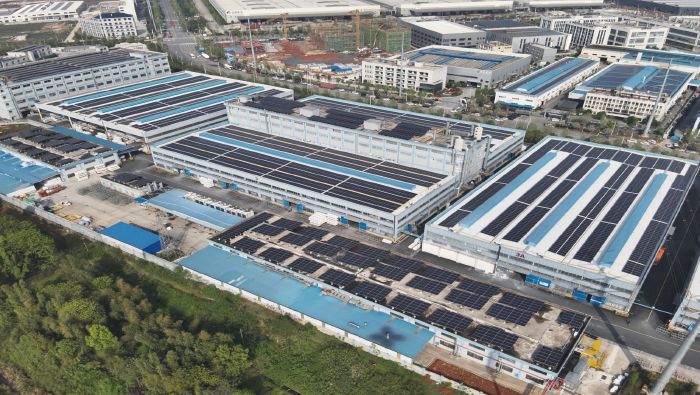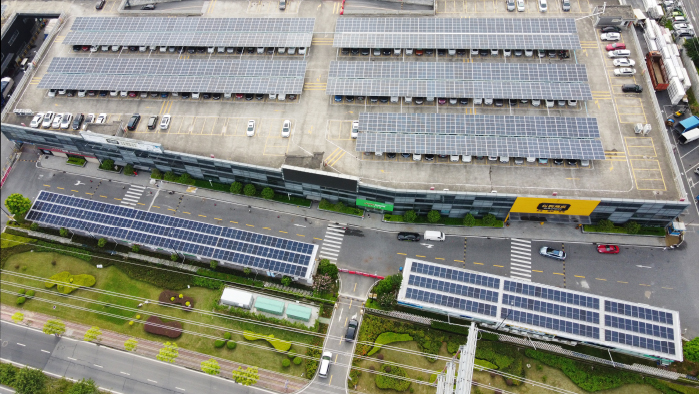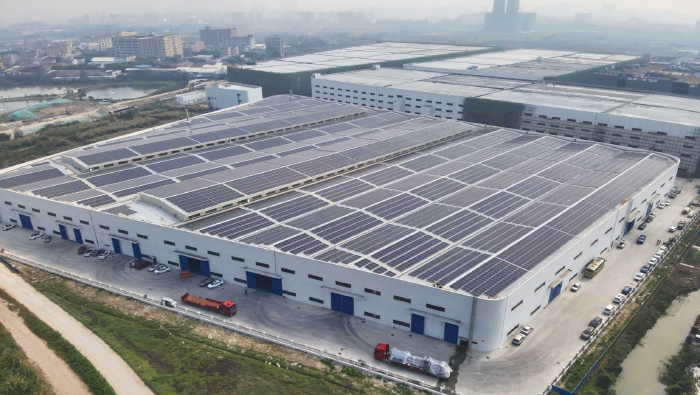As a renewable energy business that is naturally green and constantly evolving, photovoltaic applications are slowly permeating every part of peoples' lives. The application field for solar power generation is expanding, ranging from distributed photovoltaic systems for homes to those for businesses and industries, from installing solar power plants on roofs and vacant land to creating a range of small photovoltaic devices.
1. Photovoltaic combined with commercial and industrial plant roof
Large-scale manufacturing facilities, grocery chains, and private businesses have favorable roof resources from a business perspective. Since the majority of these businesses use a lot of electricity, there may be enormous profit if the energy roof is used wisely. Additionally, because this type of business has long-term property rights—typically more than 20 years—it is better suited for the development of megawatts above large roof power plants. This helps the business not only solve the problem of electricity but also significantly benefits the social economy and the environment.

Due to the large, flat roofs, high electricity prices, and high power consumption of industrial and commercial buildings, there is a huge installed capacity and power generation as well. Additionally, industrial and commercial power plants are superior investments from an investment standpoint. Installing photovoltaic power plants on commercial and industrial roofs can help reduce peak electricity prices, provide a healthy income from electricity bills, and effectively revive fixed assets. It can also lower factory interior temperatures and encourage energy and emission reduction.
2. Base Station for Photovoltaic + Communication
China Tower Group needs to make sure that the power supply is constant around-the-clock because it possesses over 1.9 million base stations, many of which are communication base stations with a broad dispersion. When there is no distributed photovoltaic system available, employees must start a diesel generator to provide a temporary power source. Diesel generators are expensive to operate and maintain, but they also have a very high installation value when combined with distributed photovoltaic power generation systems.
Inverters and convergence boxes are fixed on the walls of the equipment room, while photovoltaic panels are typically put on the equipment room's roof, the surrounding open space, and the pylons.
When the weather is favorable, the base station will utilize photovoltaic systems to create electricity; when it's gloomy and rainy, it will use utility power; when it's severe weather and there are power outages, it will use battery power. By doing this, the battery's service life will be maximized.
3. Water plant (sewage treatment/water purification plant) plus photovoltaic
The Ministry of Housing and Construction has released data showing that the nation has amassed over 4000 sewage treatment plants and almost 4000 water plants. Both types of plants have large areas dedicated to water treatment ponds. Additionally, the average yearly power consumption of sewage treatment plants is relatively high. Installing photovoltaic offers significant financial benefits; photovoltaic power generation projects utilize the roofs of sewage treatment plants, as well as sedimentation tanks, biochemical tanks, and contact pools. Above, installing solar photovoltaic panels offers special benefits in terms of space. Furthermore, since the majority of sewage plants are owned by the local government, business continuity is ensured.
4. Solar power plus a parking lot/carport
One of the easiest and most practical ways to integrate with a building is a photovoltaic carport. Incorporating photovoltaic into carports, corridors, and other spaces, along with charging piles and other amenities, can enhance not only the overall rate of urban space utilization but also optimize people's travel convenience. With its sunshade, rain protection, and strong heat absorption capabilities, photovoltaic carports are becoming more and more popular as renewable energy sources for hospitals, schools, business spaces, industrial parks, and battery-powered cars.There are many different varieties of photovoltaic carport brackets. The traditional ones are classified as single-column unidirectional, double-column unidirectional, single-column bidirectional, and so on. The bracket system, battery module array, lighting and control inverter system, charging device system, lightning protection system, and grounding system are the essential components of a photovoltaic carport. The major components of the support system are the battery module array fasteners, purlins attached to the inclined beams for supporting the solar cell module array, support columns, and inclined beams fixed between the support columns.

5. Solar Power + Gas Station
An increasing number of oil majors have entered the new energy sector in recent years. Oil corporations like Sinopec, PetroChina, and Shell have started designing PV gas station projects in China. PV gas stations will also present a new avenue for development as a result of the conventional energy firms' numerous trial projects operating successfully. Oil giants are also vying for new hotspots that include charging heaps, photovoltaic building integration, and new energy vehicles.
ImageRecently, a photovoltaic power station was built on top of a petrol station on Hangzhou's South Ring Road. The gas station canopy has two rows of pillars and is constructed of profiled steel. A total of 630 m2 of colored steel tiles make up the canopy's roof. 176 pieces of 285Wp polycrystalline silicon modules total, with 8 strings of modules installed and a total capacity of 50.16kWp. Additionally, there is 1 set of 50kW string inverters installed in this project, which is connected to the power grid via "self-generation and self-consumption, with the remaining power going online." "Self-generation and self-consumption of residual power on the Internet" as a means of grid connection.Based on initial data, the nation has a minimum of 130,000 gas stations. Assuming half of these stations have 10kW distributed photovoltaic systems installed, the nation will have constructed 650,000kW worth of distributed photovoltaic projects!
6. Regional Chain/Warehouse Center/PV+Logistics
Building a logistics industry, new energy industry, and e-commerce on one of the public and open service platforms, as well as cultivating and incubating business enterprises, e-commerce enterprises, and logistics enterprises, will enable the creation of a distinctive green business ecosystem. Logistics centers are made possible by the development of industrial parks, new energy development, and the organic fusion of the Internet.

It is believed that the Cainiao Network Logistics Park has been designed to set aside approximately 20,000 acres of land, with an estimated roof area of over 5 million square meters and an available area of over 4 million square meters. It is anticipated that the power plant can be built to a capacity of over 300 megawatts. In March 2017, Jingdong made an announcement shocking the industry by announcing that Jingdong Logistics would be building an 800MW distributed photovoltaic power plant on 8 million square meters of roof space. Furthermore, the integration of PV technology with the rooftops and underutilized land of the numerous logistics and storage facilities located around the nation can yield significant economic and environmental advantages.







